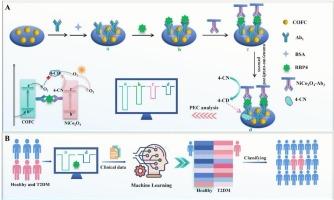Machine learning-assisted BMOFs-derived 1D NiCo2O4 nanozyme photoelectrochemical detection of RBP4 for type 2 diabetes diagnosis
IF 13.2
1区 工程技术
Q1 ENGINEERING, CHEMICAL
引用次数: 0
Abstract
Retinol binding protein 4 (RBP4) is a potential marker for the diagnosis of Type 2 diabetes mellitus (T2DM). Due to the low sensitivity of RBP4 detection technology, the application of RBP4 in the early diagnosis of T2DM remains to be further explored. Herein, a highly sensitive photoelectrochemical (PEC) biosensor based on chitosan-modified covalent organic framework (COFC) and bimetallic metal organic frameworks-derived one-dimensional (1D) NiCo2O4 nanorods is developed for the detection of serum RBP4, using machine learning to assist in intelligent diagnosis of T2DM. Benefiting from the excellent photoelectric properties of COFC and the multifunctional signal amplification of 1D NiCo2O4 nanozyme, this PEC biosensor has a broad detection range from 10 to 107 fg/mL and a low detection limit of 8 fg/mL. Importantly, the established PEC platform for RBP4 analysis in human serum can effectively distinguish healthy individuals from T2DM patients. Moreover, this machine learning is employed to probe the hidden potential pattern in the proposed PEC technology data, and the accuracy of machine learning for T2DM intelligent diagnosis can reach 95.8 %. The combination of PEC biosensor and machine learning provides an efficient tool for RBP4 analysis, aiding in the early diagnosis of T2DM.

机器学习辅助bmofs衍生的1D NiCo2O4纳米酶光电化学检测RBP4用于2型糖尿病诊断
视黄醇结合蛋白4 (RBP4)是诊断2型糖尿病(T2DM)的潜在标志物。由于RBP4检测技术的敏感性较低,RBP4在T2DM早期诊断中的应用还有待进一步探索。本文基于壳聚糖修饰的共价有机框架(COFC)和双金属金属有机框架衍生的一维NiCo2O4纳米棒,开发了一种高灵敏度的光电化学(PEC)生物传感器,用于检测血清RBP4,利用机器学习辅助T2DM的智能诊断。得益于COFC优异的光电特性和1D NiCo2O4纳米酶的多功能信号放大,该PEC生物传感器具有10 ~ 107 fg/mL的宽检测范围和8 fg/mL的低检测限。重要的是,建立的用于人血清RBP4分析的PEC平台可以有效区分健康人与T2DM患者。此外,利用该机器学习方法对所提出的PEC技术数据中的潜在模式进行挖掘,机器学习用于T2DM智能诊断的准确率可达到95.8% %。PEC生物传感器与机器学习的结合为RBP4分析提供了有效的工具,有助于T2DM的早期诊断。
本文章由计算机程序翻译,如有差异,请以英文原文为准。
求助全文
约1分钟内获得全文
求助全文
来源期刊

Chemical Engineering Journal
工程技术-工程:化工
CiteScore
21.70
自引率
9.30%
发文量
6781
审稿时长
2.4 months
期刊介绍:
The Chemical Engineering Journal is an international research journal that invites contributions of original and novel fundamental research. It aims to provide an international platform for presenting original fundamental research, interpretative reviews, and discussions on new developments in chemical engineering. The journal welcomes papers that describe novel theory and its practical application, as well as those that demonstrate the transfer of techniques from other disciplines. It also welcomes reports on carefully conducted experimental work that is soundly interpreted. The main focus of the journal is on original and rigorous research results that have broad significance. The Catalysis section within the Chemical Engineering Journal focuses specifically on Experimental and Theoretical studies in the fields of heterogeneous catalysis, molecular catalysis, and biocatalysis. These studies have industrial impact on various sectors such as chemicals, energy, materials, foods, healthcare, and environmental protection.
 求助内容:
求助内容: 应助结果提醒方式:
应助结果提醒方式:


